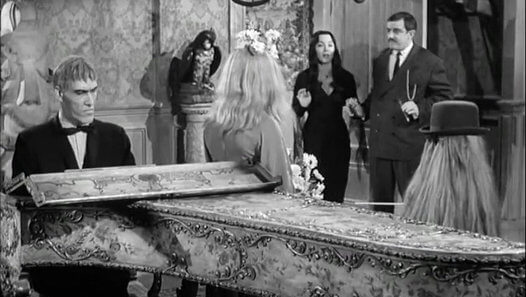50 years ago today, The Addams Family lurched off TV forever

Network television went through a brief, strange fascination with monster-based sitcoms in the mid-1960s. There must have been something in the air. CBS had The Munsters, a series created by Joe Connelly and Bob Mosher of Leave It To Beaver fame. But ABC beat them to the punch by six whole days in September 1964 with The Addams Family, a cheerfully macabre domestic face based on Charles Addams’ famed New Yorker cartoons from the 1930s and ’40s. Both shows lasted two seasons apiece, expiring in the spring of 1966. The Munsters managed to outlast The Addams Family on the prime time schedule by only about a month. “Ophelia’s Career,” the final Addams installment of the original series, first aired on April 8, 1966.
The episode, perhaps disappointingly, is nothing close to a proper series finale. The plot doesn’t even center around one of the main Addams characters, like Gomez (John Astin) or Morticia (Carolyn Jones). Instead, the focus of the episode is Morticia’s flighty blonde sister Ophelia Frump (also Jones), making her fourth guest appearance on the show. She’s been jilted again, this time for judo flipping her boyfriend, so the Addams try to cheer her up by grooming her as an opera singer. It’s not such a far-fetched idea, since Ophelia has the rare, superhuman ability to harmonize with herself. Though the connection is not made explicit, the scenes of Ophelia’s painful musical training are very similar to a subplot in Citizen Kane, complete with a temperamental, Italian-accented instructor. At least the episode provides nice showcase moments for Cousin Itt (Felix Silla), Uncle Fester (Jackie Coogan), and Lurch (Ted Cassidy).
Predictably, some of the script’s topical references have been largely lost to time. At one point, for instance, Ophelia strokes Uncle Fester’s face and says approvingly, “There’s something about a sulfuric acid man.” This is a nod to a then-popular ad campaign for Aqua Velva aftershave lotion and its similar slogan, “There’s something about an Aqua Velva man.” Ophelia, by the way, is meant to be Fester’s biological niece.
During a scene set in the Addams’ playroom, meanwhile, composer Vic Mizzy manages to sneak in a few bars of a familiar melody he wrote for another project. In the 1960s, New York City hired Mizzy to compose a catchy jingle for a public service announcement about the dangers of crossing the street “in the middle, in the middle, in the middle of the block.” That song turns up in instrumental form here. Whether this is sly cross-referencing or lazy recycling on Mizzy’s part is debatable.